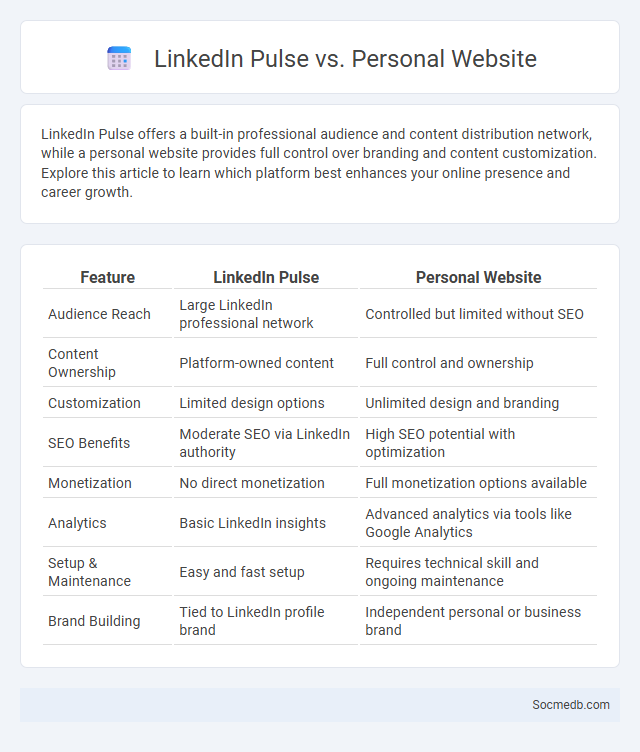
Photo illustration: LinkedIn Pulse vs Personal Website
LinkedIn Pulse offers a built-in professional audience and content distribution network, while a personal website provides full control over branding and content customization. Explore this article to learn which platform best enhances your online presence and career growth.
Table of Comparison
| Feature | LinkedIn Pulse | Personal Website |
|---|---|---|
| Audience Reach | Large LinkedIn professional network | Controlled but limited without SEO |
| Content Ownership | Platform-owned content | Full control and ownership |
| Customization | Limited design options | Unlimited design and branding |
| SEO Benefits | Moderate SEO via LinkedIn authority | High SEO potential with optimization |
| Monetization | No direct monetization | Full monetization options available |
| Analytics | Basic LinkedIn insights | Advanced analytics via tools like Google Analytics |
| Setup & Maintenance | Easy and fast setup | Requires technical skill and ongoing maintenance |
| Brand Building | Tied to LinkedIn profile brand | Independent personal or business brand |
LinkedIn Pulse vs Personal Website: Overview
LinkedIn Pulse offers a built-in audience of over 900 million professionals, enabling immediate visibility and engagement with industry-specific content, while personal websites require organic traffic-building strategies. Unlike LinkedIn Pulse, which benefits from established network effects and seamless sharing within professional circles, personal websites provide full control over branding, SEO optimization, and content customization. Businesses and individuals often leverage LinkedIn Pulse for thought leadership and real-time interaction, whereas personal websites serve as comprehensive digital portfolios and centralized hubs for diverse content and personal branding.
Content Ownership and Control
Content ownership and control on social media platforms remain critical issues as users generate vast amounts of data daily. Platforms like Facebook, Instagram, and Twitter often retain broad rights to user content, impacting individual control over intellectual property and privacy. Understanding terms of service and leveraging tools for content management is essential for protecting digital assets and maintaining autonomy online.
Audience Reach and Engagement
Social media platforms like Facebook, Instagram, and TikTok enable brands to expand audience reach by targeting specific demographics using advanced algorithms and data analytics. High engagement rates, measured through likes, shares, comments, and click-through rates, indicate strong audience interaction and brand resonance. Optimizing content with relevant keywords, hashtags, and interactive features further boosts visibility and user participation across social networks.
SEO Benefits and Discoverability
Social media platforms enhance SEO benefits by generating high-quality backlinks and increasing website traffic through shared content. Optimized social profiles and consistent posting improve brand visibility, boosting discoverability on search engines. Engagement metrics such as shares, likes, and comments signal content relevance, positively influencing search rankings.
Platform Purpose and Brand Positioning
Social media platforms serve distinct purposes ranging from professional networking and brand promotion to content sharing and community building. Effective brand positioning on these platforms requires aligning your messaging with the platform's primary function, such as LinkedIn for career-oriented engagement or Instagram for visual storytelling. Your brand's unique value proposition must resonate with the audience's expectations to maximize reach and engagement.
Analytics and Performance Tracking
Social media analytics tools provide comprehensive data on audience demographics, engagement rates, and content reach, enabling businesses to refine their marketing strategies. Performance tracking metrics such as click-through rates, conversion rates, and follower growth offer actionable insights for optimizing campaigns. Leveraging these analytics enhances decision-making and maximizes return on investment across platforms like Facebook, Instagram, and Twitter.
Monetization Opportunities
Social media platforms offer diverse monetization opportunities including sponsored posts, affiliate marketing, and brand collaborations that enable content creators to generate revenue. Influencers leverage audience engagement metrics to attract partnerships, while platforms like YouTube and Instagram provide built-in monetization tools such as ads and subscription models. Emerging trends include social commerce and virtual gifts, expanding revenue streams for businesses and individual creators.
Networking and Professional Connections
Social media platforms enable you to build and maintain professional connections by providing access to a global network of industry experts, potential employers, and collaborators. Leveraging LinkedIn, Twitter, and niche online communities enhances your ability to showcase expertise, share insights, and discover career opportunities. Consistent engagement and authentic networking help expand your influence and foster meaningful relationships that can advance your professional growth.
Ease of Use and Content Management
Social media platforms offer intuitive interfaces designed for ease of use, enabling users to quickly create, share, and interact with content across multiple devices. Advanced content management tools facilitate organized scheduling, tagging, and analytics, allowing seamless control over posts and audience engagement. These features enhance user experience by simplifying navigation and optimizing content distribution strategies.
Choosing the Right Platform for Your Goals
Choosing the right social media platform depends on your target audience demographics, content type, and marketing goals. Instagram and TikTok excel in visual storytelling and engaging younger users, while LinkedIn is ideal for B2B networking and professional branding. Understanding these platform-specific strengths enhances your social media strategy and maximizes audience engagement.
 socmedb.com
socmedb.com